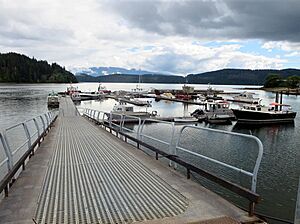Coal Harbour (Vancouver Island) facts for kids
Coal Harbour is a small community found on the northern part of Vancouver Island in British Columbia, Canada. It sits on the north side of Holberg Inlet, which is part of the Quatsino Sound area. The name "Coal Harbour" comes from a small coal mine that started there in 1883, but it wasn't very successful.
The most important business in the village was whaling. Coal Harbour was the very last whaling station in British Columbia. It closed down in 1967. The whaling station actually used buildings that were originally part of a RCAF base.
A Look Back: RCAF Coal Harbour
During World War II, Coal Harbour was home to a base for the Royal Canadian Air Force. This base was important for seaplane patrols. These planes flew over the Northern Pacific Ocean to help protect the coast.
Many of the original buildings from the RCAF base are still standing today. For example, the local general store used to be the base's gymnasium. The officers' barracks, where the military leaders lived, still overlooks the harbour.
Planes like the RCAF Supermarine Stranraer and later the Canso-A were based here. Canso-As were Canadian-built Consolidated PBY Catalina flying boats. To protect the base, workers built anti-aircraft guns and strong concrete forts. Sadly, one Stranraer plane and its entire crew were lost during the war. No one knows exactly what happened.
Today, you can visit a small, free museum dedicated to the RCAF station. It was built and is looked after by a private person. The museum is located inside the only Canso hangar that is still left.
The Whaling Station
After World War II ended, a company called B.C. Packers bought the old RCAF buildings. They turned them into a whaling station.
Whales were caught by a fleet of up to five small ships called "chasers." These ships had special harpoon guns to catch the whales. Once caught, the whales were brought to the station. A steam-powered machine pulled them up a main ramp. This ramp was the same one planes used to use!
Workers then "flensed" the whales. This means they carefully stripped off the blubber (fat). The rest of the whale was processed indoors. They made useful things like protein feed for animals and fertilizer. The entire plant was powered by two large steam engines. These engines came from US destroyer ships used in World War II.
Japanese whalers also worked with Canadian partners at Coal Harbour. The Taiyo group, which is now called Maruha Nichiro, ran the fisheries from 1962 to 1967. They mostly caught sei, sperm, and fin whales. Some blue and humpback whales were also caught.
Canada Packers took over the facility after Taiyo left in 1967. However, the station didn't operate much longer. It sat empty until it was sold for scrap metal. The entire station was taken apart between 1972 and 1975.
Coal Harbour Today
In the 1970s, a copper mine opened near Coal Harbour. It operated for many years until 1996.
Today, not many of the original World War II buildings remain. However, the general store and the commanding officer's barracks are still standing. They were still being used in 2010.
The community is connected to Port Hardy by a good paved road. The local school in Coal Harbour has closed down. Students now travel to nearby Port Hardy for their classes. Coal Harbour has become a "bedroom community" for Port Hardy. This means many people live in Coal Harbour but work in Port Hardy.
Even so, Coal Harbour still has some local businesses. There are seaplane services and connections to major fishing lodges. You can also find a general store and a local government wharf.
The village is also famous for having a giant jawbone from a blue whale. Nearby, you'll find the main community and headquarters of the Quatsino First Nation. This is the band government for the Gwatʼsinux group of the Kwakwakaʼwakw people.
See also
- Coal Harbour Water Aerodrome
- List of World War II-era fortifications on the British Columbia Coast
- List of Kwakwakaʼwakw villages


